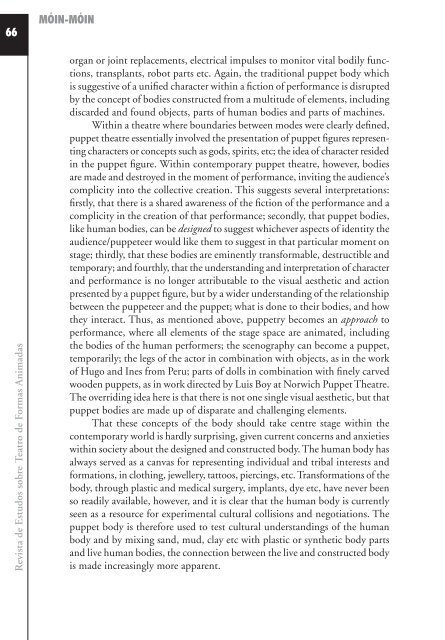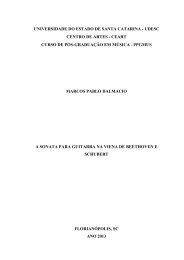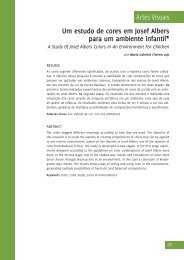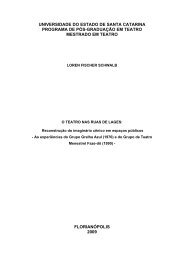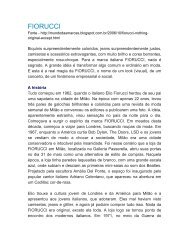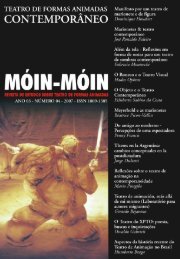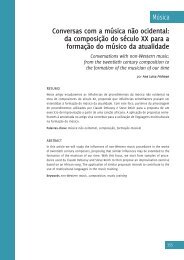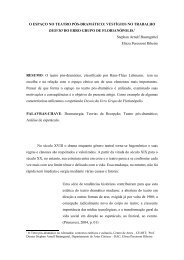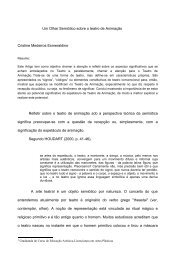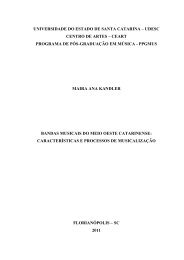Edição e distribuição www.designeditora.com.br Tipologia Adobe ...
Edição e distribuição www.designeditora.com.br Tipologia Adobe ...
Edição e distribuição www.designeditora.com.br Tipologia Adobe ...
Create successful ePaper yourself
Turn your PDF publications into a flip-book with our unique Google optimized e-Paper software.
66<<strong>br</strong> />
Revista de Estudos so<strong>br</strong>e Teatro de Formas Animadas<<strong>br</strong> />
MÓIN-MÓIN<<strong>br</strong> />
organ or joint replacements, electrical impulses to monitor vital bodily functions,<<strong>br</strong> />
transplants, robot parts etc. Again, the traditional puppet body which<<strong>br</strong> />
is suggestive of a unified character within a fiction of performance is disrupted<<strong>br</strong> />
by the concept of bodies constructed from a multitude of elements, including<<strong>br</strong> />
discarded and found objects, parts of human bodies and parts of machines.<<strong>br</strong> />
Within a theatre where boundaries between modes were clearly defined,<<strong>br</strong> />
puppet theatre essentially involved the presentation of puppet figures representing<<strong>br</strong> />
characters or concepts such as gods, spirits, etc; the idea of character resided<<strong>br</strong> />
in the puppet figure. Within contemporary puppet theatre, however, bodies<<strong>br</strong> />
are made and destroyed in the moment of performance, inviting the audience’s<<strong>br</strong> />
<strong>com</strong>plicity into the collective creation. This suggests several interpretations:<<strong>br</strong> />
firstly, that there is a shared awareness of the fiction of the performance and a<<strong>br</strong> />
<strong>com</strong>plicity in the creation of that performance; secondly, that puppet bodies,<<strong>br</strong> />
like human bodies, can be designed to suggest whichever aspects of identity the<<strong>br</strong> />
audience/puppeteer would like them to suggest in that particular moment on<<strong>br</strong> />
stage; thirdly, that these bodies are eminently transformable, destructible and<<strong>br</strong> />
temporary; and fourthly, that the understanding and interpretation of character<<strong>br</strong> />
and performance is no longer attributable to the visual aesthetic and action<<strong>br</strong> />
presented by a puppet figure, but by a wider understanding of the relationship<<strong>br</strong> />
between the puppeteer and the puppet; what is done to their bodies, and how<<strong>br</strong> />
they interact. Thus, as mentioned above, puppetry be<strong>com</strong>es an approach to<<strong>br</strong> />
performance, where all elements of the stage space are animated, including<<strong>br</strong> />
the bodies of the human performers; the scenography can be<strong>com</strong>e a puppet,<<strong>br</strong> />
temporarily; the legs of the actor in <strong>com</strong>bination with objects, as in the work<<strong>br</strong> />
of Hugo and Ines from Peru; parts of dolls in <strong>com</strong>bination with finely carved<<strong>br</strong> />
wooden puppets, as in work directed by Luis Boy at Norwich Puppet Theatre.<<strong>br</strong> />
The overriding idea here is that there is not one single visual aesthetic, but that<<strong>br</strong> />
puppet bodies are made up of disparate and challenging elements.<<strong>br</strong> />
That these concepts of the body should take centre stage within the<<strong>br</strong> />
contemporary world is hardly surprising, given current concerns and anxieties<<strong>br</strong> />
within society about the designed and constructed body. The human body has<<strong>br</strong> />
always served as a canvas for representing individual and tribal interests and<<strong>br</strong> />
formations, in clothing, jewellery, tattoos, piercings, etc. Transformations of the<<strong>br</strong> />
body, through plastic and medical surgery, implants, dye etc, have never been<<strong>br</strong> />
so readily available, however, and it is clear that the human body is currently<<strong>br</strong> />
seen as a resource for experimental cultural collisions and negotiations. The<<strong>br</strong> />
puppet body is therefore used to test cultural understandings of the human<<strong>br</strong> />
body and by mixing sand, mud, clay etc with plastic or synthetic body parts<<strong>br</strong> />
and live human bodies, the connection between the live and constructed body<<strong>br</strong> />
is made increasingly more apparent.


